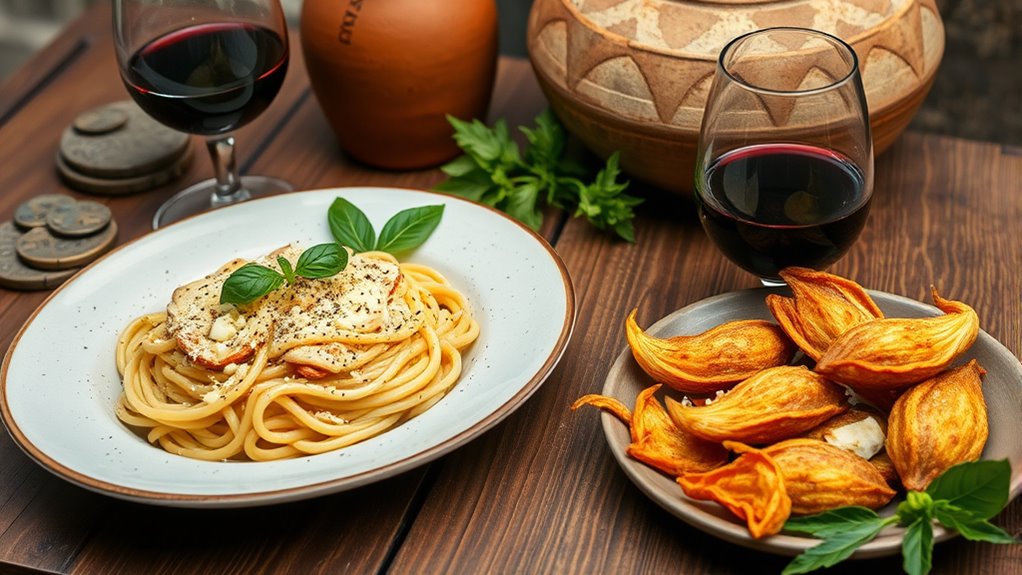Ancient Roman culinary traditions heavily influence modern Italian dishes, shaping ingredients, flavors, and techniques you enjoy today. You’ll notice the use of herbs like rosemary and sage, cheeses such as Pecorino, and staple ingredients like olive oil and vinegar, all rooted in Roman practices. Their resourcefulness led to creative substitutions that still define regional flavors. If you explore further, you’ll discover how centuries of ingenuity continue to influence Italy’s beloved culinary landscape.
Key Takeaways
- Many modern Italian dishes trace their origins to Roman recipes emphasizing simple, flavorful ingredients like herbs, cheeses, and bread.
- Roman culinary practices introduced fermented sauces such as garum, evolving into anchovy-based condiments used today.
- Ingredient substitutions and resourcefulness in Roman cooking laid the groundwork for regional variations in Italian cuisine.
- Classic Roman bread and pasta recipes, like focaccia and simple pasta sauces, remain staples in contemporary Italy.
- Roman use of preserved ingredients and seasoning techniques continue to influence Italian flavor profiles and culinary traditions.

Many of the flavors and ingredients we associate with modern Italian cuisine can be traced back to the culinary practices of ancient Rome. You may notice how certain dishes, ingredients, and cooking techniques have persisted through centuries, shaping what we now consider classic Italian fare. Roman culinary traditions laid the groundwork for many of these practices, emphasizing simple yet flavorful combinations that remain relevant today. As you explore Italian dishes, you’ll find that the use of herbs, cheeses, and breads echoes those ancient Roman recipes, demonstrating a desire for hearty, accessible meals.
Ancient Roman culinary roots influence modern Italian flavors and simple, hearty dishes.
Roman cooks were skilled at ingredient substitutions, adapting available resources to create satisfying dishes. For example, they often replaced expensive ingredients with more affordable alternatives without sacrificing flavor. This approach persists in modern Italian cooking, where regional and seasonal variations influence ingredient choices. When certain ingredients were scarce or costly, cooks would substitute ingredients that provided similar taste and texture. Think of how contemporary cooks might swap fresh basil for dried herbs or use different types of cheeses based on what’s available locally. This flexibility owes much to Roman culinary traditions, where resourcefulness was essential for daily meals.
The influence of Roman ingredient substitutions extends to popular dishes like pasta sauces and stews. For instance, ancient Romans used garum—an fermented fish sauce—as a seasoning, which can be seen as a precursor to modern anchovy-based sauces. Similarly, they relied heavily on olive oil, which remains a staple in Italian kitchens, and used vinegar, wine, and herbs to enhance flavors. By understanding these substitutions, you can appreciate how adaptable Roman cooking was, and how it set the stage for the diverse regional cuisines you enjoy today.
Furthermore, many of the ingredients used in modern Italian dishes have Roman origins. Herbs like rosemary, sage, and oregano were staples in ancient Roman gardens, and their use persists in contemporary recipes. Cheeses such as Pecorino and Ricotta have roots in Roman cheese-making traditions, and even bread recipes, like focaccia, have ancient origins. Recognizing these connections helps you see how the core ingredients of Italian cuisine have been passed down through generations, often adapted through ingredient substitutions that reflect local availability and tastes.
In essence, by understanding Roman culinary traditions and their emphasis on ingredient substitutions, you gain a deeper appreciation for the flexibility and richness of Italian cuisine. These ancient practices have helped shape a culinary landscape that is both rooted in history and wonderfully adaptable, allowing each region to put its unique stamp on traditional dishes. So, next time you enjoy an Italian meal, remember that you’re tasting centuries of ingenuity and resourcefulness that continue to define the country’s culinary identity.
Frequently Asked Questions
How Did Roman Culinary Techniques Evolve Over Time?
You see, Roman culinary techniques evolved as they refined their methods, like Roman wine making, which became more sophisticated over time. They also expanded their use of ancient condiments, such as garum, to enhance flavors. These innovations influenced cooking practices, blending new ingredients and techniques. Over centuries, these methods grew more refined, shaping the foundation for many modern Italian dishes you enjoy today.
Are There Specific Roman Ingredients Still Used Today?
Did you know that some Roman ingredients are still used today? For example, herbs like fennel and coriander come from the Roman spice trade, which was crucial for flavoring dishes. Additionally, Italy’s ancient wine production techniques, rooted in Roman practices, continue to influence modern winemaking. These ingredients and methods connect you to a rich culinary heritage, showcasing how Roman innovations remain essential to Italian cuisine.
Which Roman Dishes Have Directly Influenced Modern Recipes?
You’ll find that Roman dishes like garum, a fermented fish sauce, directly influence modern Italian recipes, showcasing Roman ingredient preservation. Roman culinary techniques, such as using olive oil and herbs, still shape your cooking today. Dishes like minestrone and various bread recipes also trace back to Roman traditions. These influences help you appreciate how ancient Roman culinary techniques continue to enrich Italy’s vibrant food culture.
How Did Roman Social Customs Influence Italian Dining Practices?
You notice that Roman banquet traditions shaped Italian dining practices by emphasizing communal eating and elaborate courses, fostering a social atmosphere. Roman table manners encouraged proper behavior, such as respectful gestures and specific sitting positions, which you still see today during formal Italian dinners. These customs create a sense of elegance and connection, making your dining experience more meaningful and rooted in centuries-old traditions.
Are Roman Food Preservation Methods Still in Use?
Roman relics remain relevant today, as some preservation methods still surface in Italian cuisine. You might notice techniques like salting and drying, echoing Roman practices, especially in regions where Roman aqueducts supplied water for food processing. Olive oil production also benefits from ancient methods, preserving flavors and nutrients. These methods persist because they’re effective, economical, and deeply rooted in Italy’s culinary history, connecting you to the timeless traditions of Roman food preservation.
Conclusion
You might be surprised to learn that over 60% of Italian recipes today still incorporate ingredients and techniques dating back to ancient Rome. This rich culinary heritage shows how deeply rooted Roman influences are in your everyday meals. By exploring these traditions, you connect with a history that’s nearly two thousand years old, making every bite a taste of the past. So next time you enjoy Italian food, remember—you’re savoring a centuries-old legacy in every dish.









